Services on Demand
Journal
Article
Indicators
-
 Cited by SciELO
Cited by SciELO -
 Access statistics
Access statistics
Related links
-
 Cited by Google
Cited by Google -
 Similars in
SciELO
Similars in
SciELO -
 Similars in Google
Similars in Google
Share
Earth Sciences Research Journal
Print version ISSN 1794-6190
Earth Sci. Res. J. vol.9 no.2 Bogotá July/Dec. 2005
SIMULATION OF NEAR-SURFACE LAYER OF THE COLOMBIAN PACIFIC OCEAN
Lev Karlin1 and Nancy Villegas2
1 Russian State Hydrometeorological University, San Petersburg, Russia, e-mail: rector@rshu.ru
2 Departamento de geociencias, Universidad Nacional de Colombia, Sede Bogotá, e-mail:nlvillegasb@unal.edu.co
RESUMEN
Este artículo muestra los resultados obtenidos en el estudio de la estructura fina termohalina de la capa sub-superficial realizado en la Cuenca del Pacífico colombiano. Se formularon modelos matemáticos para diferentes regímenes de capas sub-superficiales. Basado en tres estaciones se realizó un análisis horario de información meteorológica, variación de espesor, temperatura y salinidad de la capa fina. Las leyes de formación de la estructura fina termohalina para la capa sub-superficial en la Cuenca del Pacífico colombiano están relacionadas con convección nocturna, mezcla viento-ondas, absorción de energía radiante y precipitación.
Palabras clave: Capa sub-superficial, estructura termohalina fina, termoclina, haloclina, mezcla viento-ondas, mezcla convectiva.
ABSTRACT
This paper presents the results provided by the fine-scale thermohaline structure of near-surface layer (NSL) study done in the Colombian Pacific Ocean (CPO). Mathematical models for different regimes of the near-surface layer are formulated. Based on three stations, an hourly analysis of meteorological data, thickness change, temperature and salinity of this layer was done. The principles of formation of the thermohaline structure for NSL over CPO are related to night convection, wind-wave mixing, volume absorption of radiant energy and precipitation.
Key words: Near-surface layer, fine-scale thermohaline structure, thermocline, halocline, wind-wave mixing, convective mixing.
INTRODUCTION
Fedorov and Ginsburg (1988) found for thermohaline structure formation in the Ocean-NSL, the following regimes: intensive wind-wave mixing (wind speed > 8 m/s), intensive convection (night, autumn-winter, during the cooling or rise of salinity in ocean), Langmuir circulation (wind speed between 3 and 10 m/s) and desalt due to precipitation.
First, Karlin et al. (1988) and later Rodhe (1991) found another regime related to horizontal advection. Finally, the regime connected to special features of the offshore thermohaline structure in polar and circumpolar regions was determined (Timokhov, 1989; Timokhov et.al, 1993).We described four mathematical models used for NSL regimes over CPO provided by data analysis in 3 stations. Hourly weather data and vertical thermohaline profiles at these stations were examined in detail, obtaining NSL thickness values, top and bottom boundaries and the corresponding temperature and salinity (Villegas, 2003). In conclusion, the predominant NSL regimes of CPO are night convection, wind-wave mixing, the volume absorption of radiant energy and regime with precipitation.
METHODOLOGY
The former data was obtained at hydrometeorological stations 14 (4° N , 78° W), 49 (2° N, 80° W) and 111(3° N, 84° W), in August and September, 2001 (Otero and Pineda, 2001), recording data during 24 hours, trying to verify the models that describe the different NSL regimes, see Figure 1. These stations covered the coastal (station 14), the offshore (station 111) and the mixing water zone (station 49), being selected according to the quasi-homogeneous classification zones (Villegas, 2002).
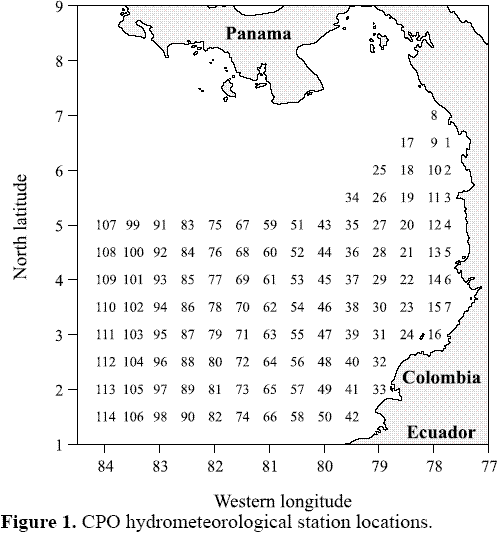
Wind-wave mixing regime
The quasi-homogeneity in temperature and salinity vertical distribution of the mixed layer in diurnal time, simplify the differential simulation without loss of accuracy, using integral methods. It is assumed the presence of mixed layer during the calculation period. The simplified expression of NSL thickness is:

where, m is an empirical constant of proportionality; h is the upper mixed layer thickness, m; is the dynamic speed, m/s; Cp is the resistance coefficient; uv is the wind speed, m/s; αb is the thermal expansion coefficient, 1/°C; qT0 is the heat flux through water-air boundary, °Cm/s. The equation to calculate temperature evolution with constant heat flux is:
is the dynamic speed, m/s; Cp is the resistance coefficient; uv is the wind speed, m/s; αb is the thermal expansion coefficient, 1/°C; qT0 is the heat flux through water-air boundary, °Cm/s. The equation to calculate temperature evolution with constant heat flux is:

where, δT0 is the change of upper mixed layer temperature for the calculated step on the time δt, °C.Equation (1) determines the upper mixed layer thickness in wind-wave mixing regime, in the case of its decrease. This happens until maximum heat flux is observed, when diurnal thermocline is formed. Thickness remain constant until the heat flux in air-water boundary decreases, then thickness increases and expansion of diurnal mixing layer is observed. In this case, the temperature and thickness evolution formulas of mixed layer must consider the formed diurnal thermocline thickness and heat flux qhT on mixed layer bottom boundary. In accordance with the Similarity Theory of profile T in the thermocline (Kitaygorodskiy, 1970; Miropolskiy, 1970 and Garnich and Kitaygorodskiy, 1978), we have:
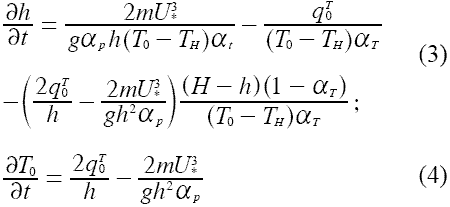
where, T0 is the water temperature in upper mixed layer, °C; TH is the water temperature in bottom boundary of mixed layer, °C; αt is the dimensionless coefficient of Self-Similarity determined according to observed data and H is the thermocline depth, m.Formulas (1), (2), (3) and (4) calculate the thickness and temperature evolution of mixed layer in wind-wave mixing regime.
Convective mixing regime
This type of convection, in absence of dynamic factors on water-air boundary, is also called free convection. In this work, convective-wind mixing took place at night, when heat flux on water-air boundary is negative, the mixed layer descends and heat flux through mixed layer bottom boundary becomes defined by the involvement hypothesis (Karlin, 1988). The equations of thickness h ad temperature T evlution of NSL in convective mixing regime are:

where, kq is dimensionless coefficient for free convection (Woods and Barkmann, 1986, Varfolomeyev and Sutyrin, 1981).Convective mixing regime is characterized by layer mixed deepening even for weak wind, due to negative heat flux in water-air boundary. These two factors together (intensive refreshing and strong wind) contribute to the deepening of layer, causing the diurnal thermocline vanish.
Sunny and weak wind weather regime
If in the ocean surface exists a convective mixed layer and the mixture of this layer is so strong that the temperature vertical gradient is zeroed, then we use heat equation in vertical direction, integrating from surface to inferior boundary of convective layer h:

here, qSo is the radiation flux through ocean-atmosphere boundary, °Cm/s; qh is the radiation flux on bottom boundary of convective layer, °Cm/s; qT0Σ is the heat flux through ocean surface caused by evaporation, turbulent heat exchange and long-wave radiation, °Cm/s.
Equation (7) requires the expression of turbulent energy balance integrated in limits of convective layer. The production of energy (generated due to forces of Archimedes) is made until z depth with the Bouguer’s law (radiation flux determined exponentially) and considering dissipation according to works of Zilitinkevich and Dearfor (1974); Dearfor et al. (1980); Dearfor and Willis (1985); Kofi (1985) and Zilitinkevich (1987), it is possible to write the energy balance turbulence equation integrated in the limits of convective layer as follows:

where, qS is the short wave emission flux to ocean surface, °Cm/s; r is the effective coefficient of weakening solar energy in sea water, m-1.In expression (8), qhT is undetermined doing necessary to analyze two stages of NSL evolution, in the first one, layer thickness increases when solar energy flux decreases or decreases when heat loss increases; causing heat exchange (involvement), the previous processes make necessary to estimate qhT. In the second stage, when solar energy flux increases or heat loss decreases, the mixed layer thickness decreases, i.e., a new convective mixing layer takes place with a thickness smaller than previous one. When h decreases qhT=0 then:

Because rh is dimensionless, it is necessary to use the expression /h*=r/1 in order to calculate it. Defining hr=h/h=h as the thickness of the mixed convective layer, so h=h/r. From (9), h is depending on qTO/qS;qS has important role because its value is maximum at noon and practically zero at night. In consequence h* decreases in sunrise to noon interval, producing a minimum convective layer thickness. After noon, mixed convective layer thickness increases and qThO, which is defined as:

where, (T0-Tz) - is the difference between water temperature of convective layer and level ,z=h+o˚C. After noon qTO/qS icreases and, it leads to an increase of h. This occurs until values qT0Σ and qS become equal, that indicates the warming up ends and usual convection begins due to surface cooling.
Precipitation regime
NSL thickness according to experimental simulation (Fedorov and Ginsburg, 1988), is determined as:

where, λ – s the involvement coefficient, which is function of falling drops diameter; t – s the time counted from the beginning of freshened layer formation, s; t0 – s the time interval from the beginning of rain to the beginning of the freshened layer formation, s; I – is the precipitation intensity, m/s; βc – s the salt compression coefficient, 1/ ‰; S0 – is the top boundary salinity of mixed freshened layer, ‰.Freshening value in layer generated during precipitation can be calculated by:

These values depend on precipitation intensity, rain duration and wind speed. In Katsaros and Buettner (1969) work, it is shown that U* during precipitation will be equal to the sum of traditional dynamic speed U* with some U*1:

where, U3*1 – is the dynamic speed in water due to turbulent influence of falling drops, m/s; uk – is the vertical speed of falling drops, m/s.The presence of thin freshened layer separated from great bulk of water over the mixed layer clearly can be observed due to a discontinuity layer that plays an important role in the evolution of this freshened layer after rain. When rain stops, salt flux through surface is equal to zero and thickness of freshened layer increases. Then, its characteristic can be defined as follows (Karlin et. al, 1988):

where, ht is the thickness of the freshened layer at time t, easured since the end of the precipitation, m; h0 is the thickness of the freshened layer at moment of end precipitation, m; δSo is the jump in salinity in the bottom of the freshened layer at the end of precipitation, ‰.This jump at time t ater end of precipitation is determined by the equation:

Equations (14) calculate the freshened layer thickness and (15) the evolution of the mentioned jump on its bottom boundary.
RESULTS
Determination of regimes according to weather data and calculated fluxes on ocean-atmosphere boundary
Depending on change of wind, air temperature, water temperature, cloudiness and precipitation, a mathematical model for calculations is determined. Inaccuracy in meteorological data can influence the behavior of used model in certain hydrometeorological station. In this section, obtained hour weather data and results of heat and salt calculated fluxes in each station, are analyzed. Station 14 was observed from 5 am (8 September, 2001) to 4 am (9 September, 2001), with precipitation registered from 5 to 10 am and at 3 pm. In those hours, values of air (Ta) and water temperature (Tw) should be smaller than other hours, an upper thin freshening layer should appear, rain be accompanied by hard wind and cloudiness must be of 6 – 8 okt. (Ginsburg et al., 1980). The figure 2 shows hourly weather characteristics and figure 3 shows results of heat and salt flux. The cloudiness data match with atmospheric aspects described below (figure 2a). During 6-7 am period, wind speed was very low, and an increase in Tw was observed (figure 2b). At night, convective process and a decrease in Tw must occur, instead at 10 p.m., a Tw increase was registered. Similar behavior occurred from 1 am to 2 am (Tw increased 0,2 °C), Figure 2. Weather data at station 14 on CPO Figure 3. Calculated heat and salt fluxes on water-air boundary at station 14 on CPO
also at 4 am. Calculated salt flux shows high values during rain (figure 3a). Minimum calculated heat flux was observed at night and maximum from 10 am to 1 pm (figure 3b).
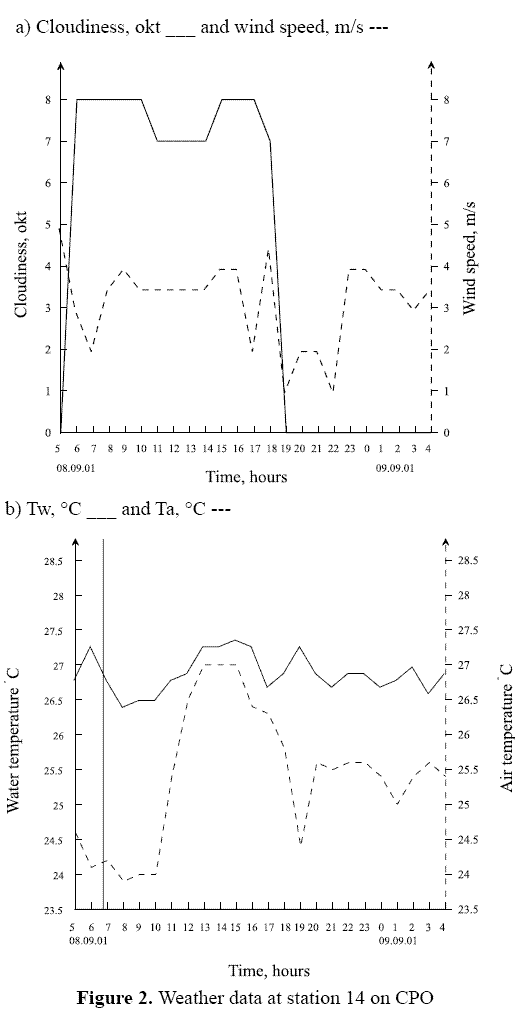
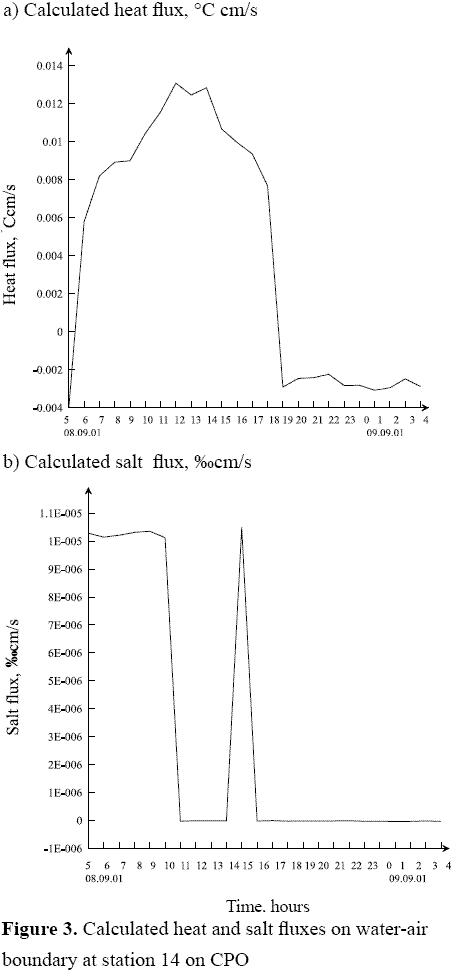
According to weather characteristics in station 14, NSL thickness and thermohaline structure will be properly described with precipitation and night convection regime models. After rain, NSL water must have less salt than before rain. At the beginning of rain NSL thickness will be small, and at the end, it will increase. Due to wind, The NSL formed by precipitation will disappear immediately after rain. Wind will create a new greater thickness NSL, more salinity and warmer water than previous one. Night convection plays an important role in NSL thickness increase.Hourly observations from 1 am (28 August, 2001) to 00 am (29 August, 2001) do not register precipitation at station 49 (figures 4 – 5) exhibiting a constant wind with relatively high speed. The NSL thickness will change depending on wind intensity: minimum thickness and warm water with low wind speed and maximum thickness and cold water with high wind speed.
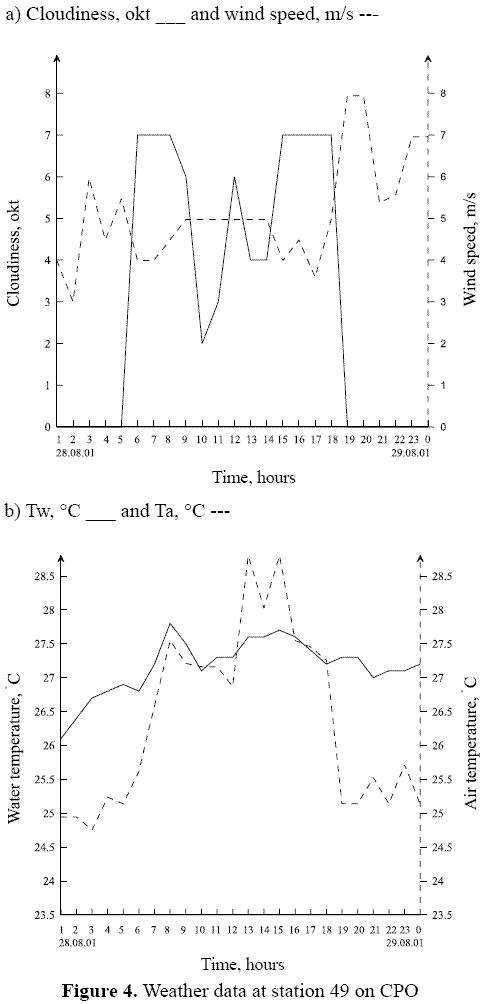
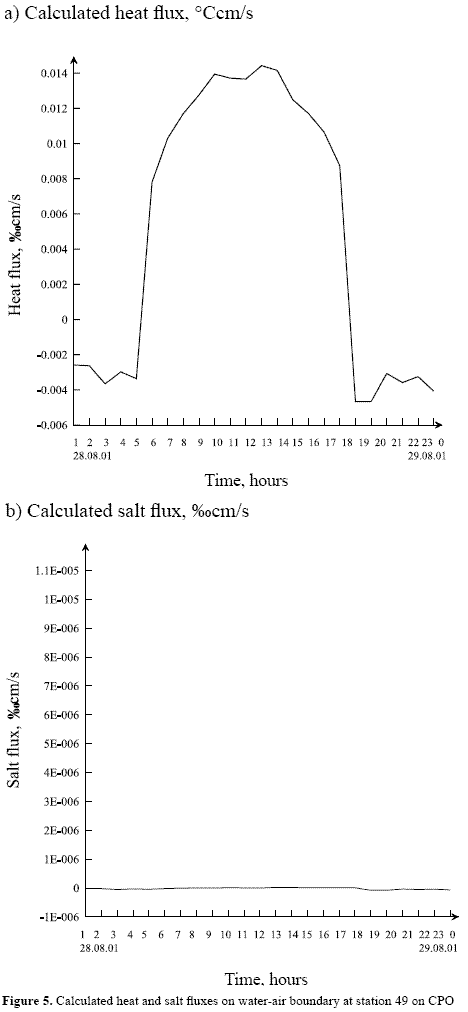
Figure 4a shows very low cloudiness only from 10 am to 11 am, and the cloudiness at 8 am was 7 okt, figure 4b shows high Ta and Tw. Ta and Tw had highest values between 1 pm and 2 pm, although wind was constant and strong enough (5 m/s). Since 6 pm to midnight there was no positive heat flux into the ocean, but an increase in Tw at 7 pm, 10 pm and 00 am was registered. The anterior erroneous observations make hard to calculate NSL thermohaline characteristics.Figure 5a shows calculated heat flux increasing due to erroneous data but at night this flux must be constant. Figure 5b shows minimum salt flux associated to no rain. NSL thermohaline characteristics will be described by night convection and wind wave mixing regime models.Figures 6 and 7 represent weather data and calculated heat and salt fluxes for station 111. This station observed from 00 (30 August, 2001) to 11 pm (31 August, 2001) registered three precipitations: from 6 to 7 am, from 9 am to 1 pm and from 6 pm to 9 pm. Cloudiness and wind speed show values associated to rain, whereas Ta and Tw increased from 1 am to 5 am and from 8 pm to 11 pm, but usually Ta and Tw usually must decrease at this time.
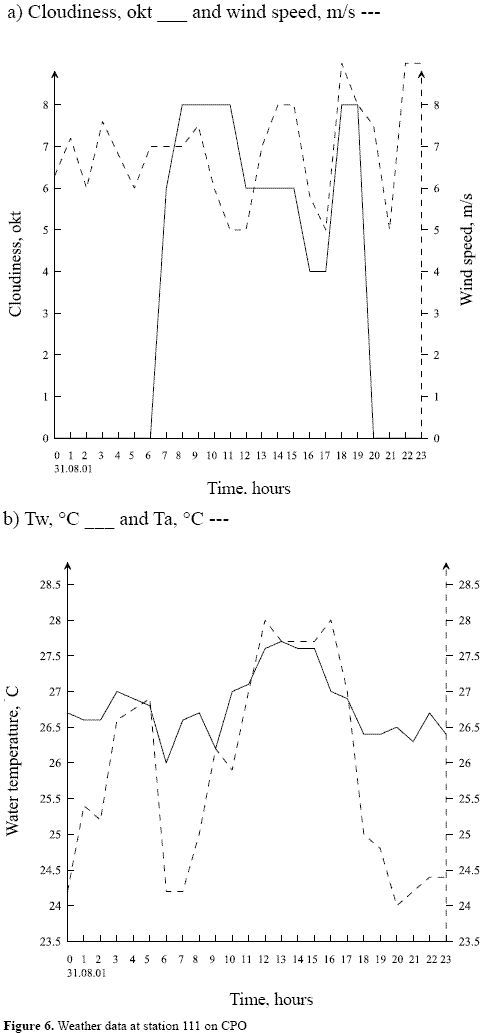
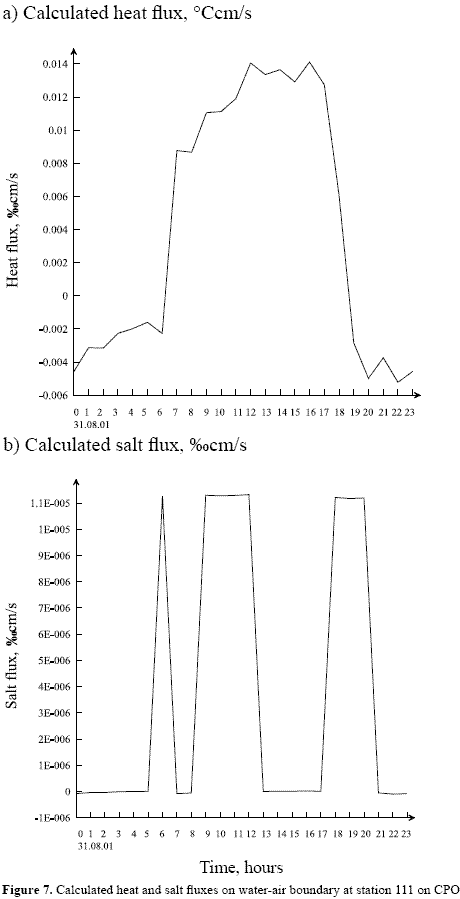
According to early hourly weather observation NSL thickness must expand at 5 am and Tw decrease. From 6 am, due to rain, a new thin layer should be generated and increase. After one hour, rain again is observed contributing to create a new thin layer with Tw change, increasing its thickness at 1 pm due to wind. The described process will be repeated during night, appearing night convection with NSL thickness expansion and Tw decreasing. Taking into account this process, NSL thermohaline characteristics of station 111 can be well described by precipitation and night convection regime model.
NSL thermohaline structure of CPO according to simulation results
Calculations of Tw evolution were performed with all regimes, because temperature factor reacts immediately and more adequately to meteorological influences. Calculations of salinity evolution were performed only with precipitation regime.Station 14 results are represented in figures 8, 9 and 10. Used regimes do not provided observed NSL thickness behavior, but shows properly Tw and salinity difference evolutions. Wind-wave mixing regime describes better Tw evolution than other ones. Salinity difference evolution is well described by precipitation regime model from 5 am to 7 pm. Until now it is impossible to say with confidence, that used models are not reliable to describe NSL characteristics in station 14 and verify data validness.
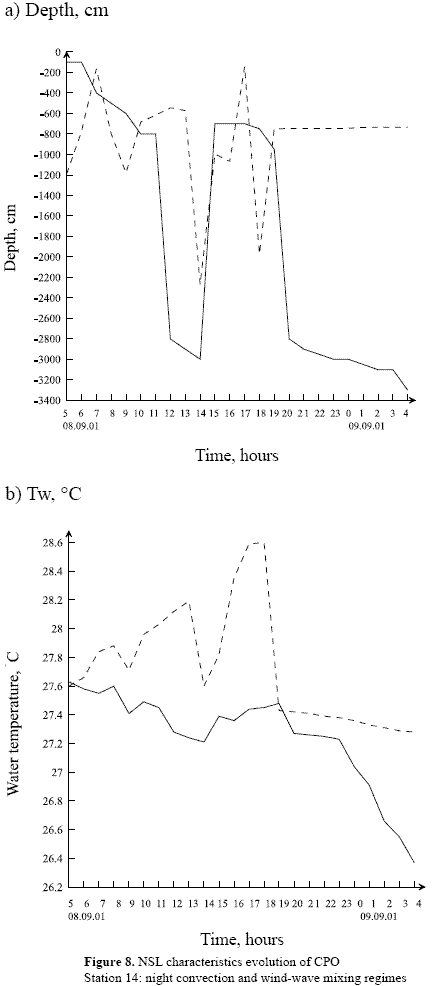
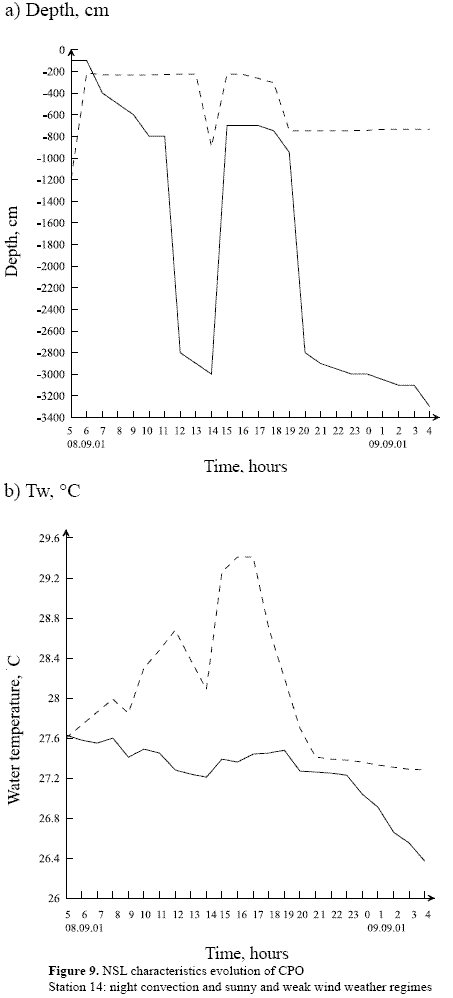
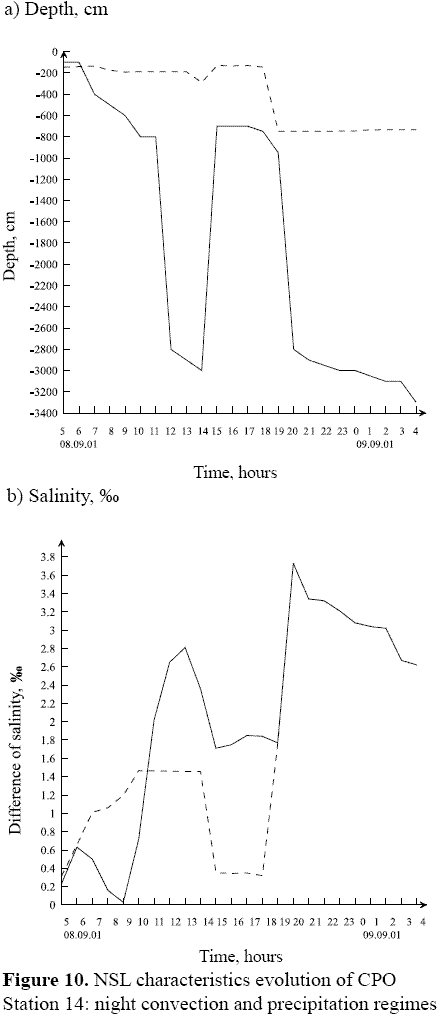
Calculated NSL characteristics at hydrometeorological station 49 are shown in figures 11-12. Here, night convection regime describes well NSL depth behavior from 1 am to 5 am and from 7 pm to 12 pm. Also there are good results with wind-wave mixing regime for the other hours. Theoretically, when there is a constant wind, NSL depth should increase (in this case so it was calculated from 9 am to 2 pm), but according to observed data it decreased, allowing to conclude that oceanographic data or wind data are erroneous (wind should decrease). For this period, sunny and weak wind weather regime, gave a very sharp decrease of NSL depth, although this change is similar to natural data. Here we also can assume not correctly registered wind data.
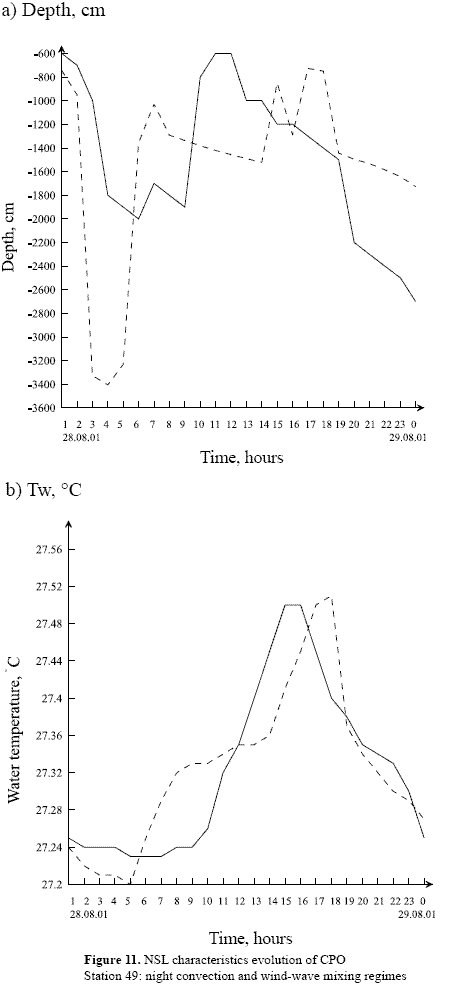
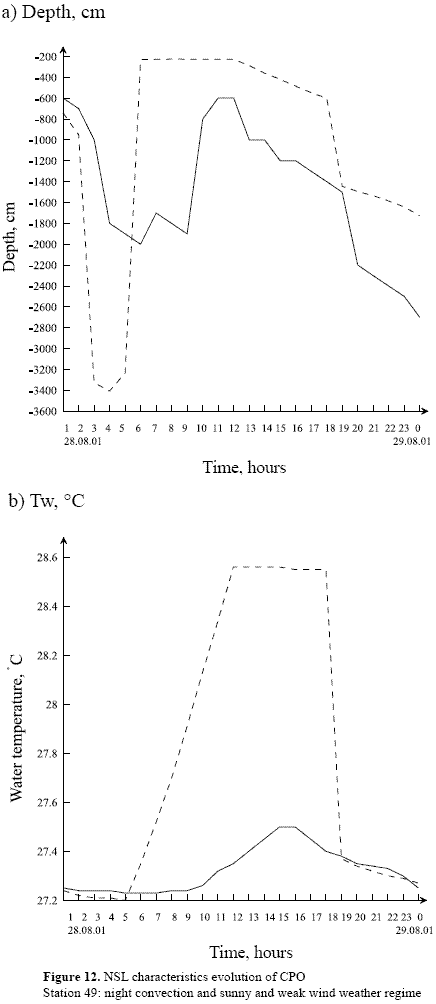
Precipitation regime at this station did not adapt, since rain was not observed. NSL Tw at station 49 is described well with examined regimes. Sunny and weak wind weather regime shows abrupt changes in Tw in day time, but preserves similarity with natural data. In general, calculations with different regimes at this station show better results, than at station 14.
Figures 13, 14 and 15 show results of calculations at hydrometeorological station 111. Here, evolution of NSL depth, Tw and salinity difference are well described with all regimes.
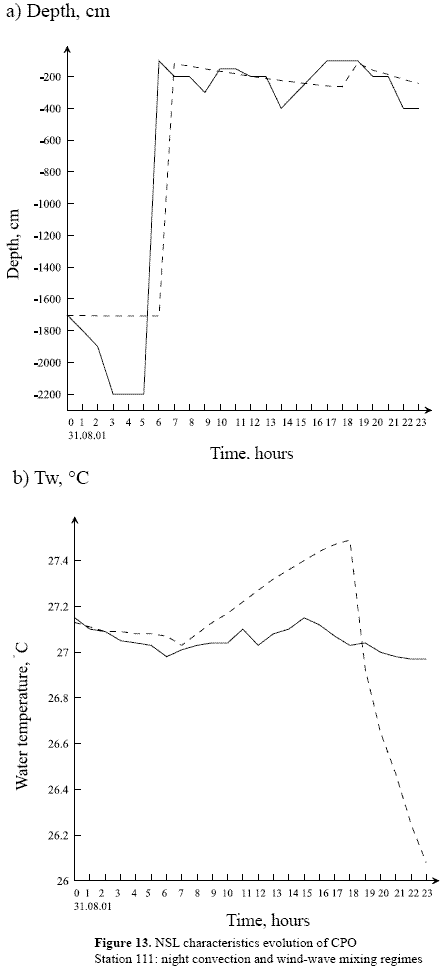
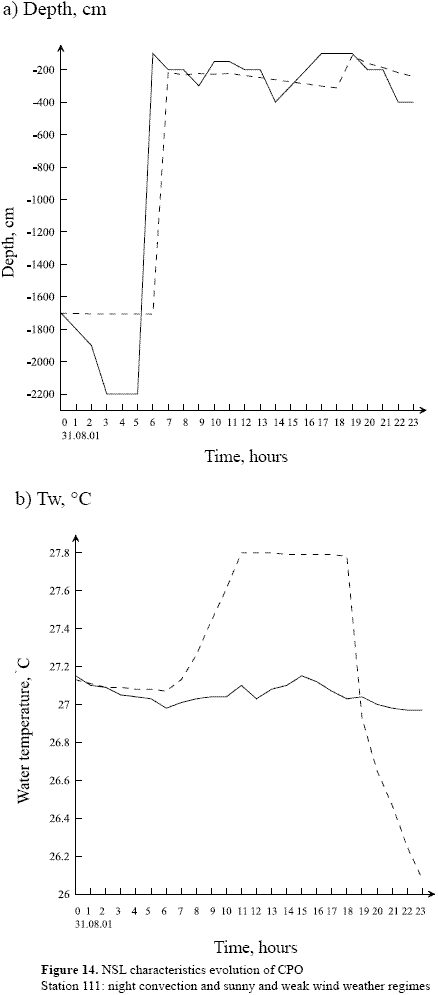
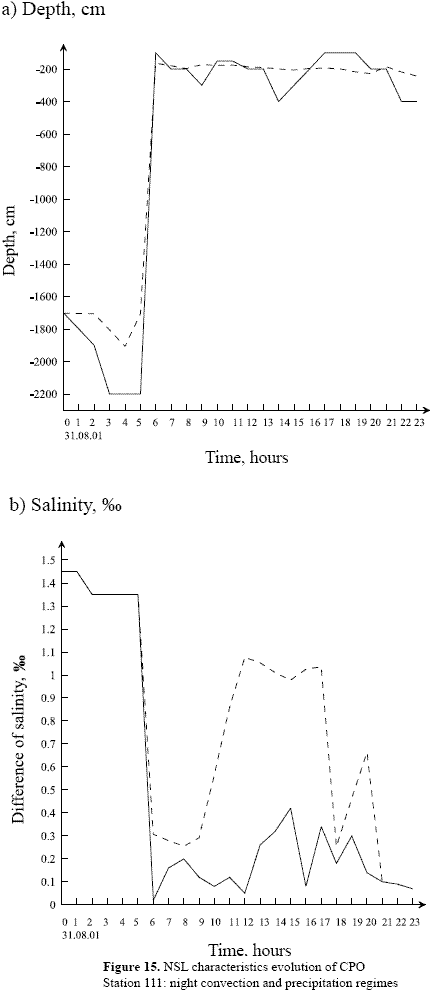
Simulation results of sunny and weak wind weather regimes, have a high differences from others regimes and preserve natural data behavior. Calculated NSL depth with night convection regime from 0 to 5 am is more similar to natural data than those obtained from 7 pm to 11pm. The precipitation regime provided the best performance from 6 pm. In general, the sunny and weak wind weather regime was more suitable due to presence of precipitation with wind. Salinity difference evolution was well enough described by precipitation regime.These models can be used for researches of NSL thermohaline characteristics of CPO, but it is necessary quality improvement of natural data.
CONCLUSIONS
NSL thermohaline structure of CPO according to simulation results with different regimes was described. On basis of data analysis and simulation results, over CPO occur four NSL regimes: night convection, wind-wave mixing, volume absorption of radiant energy and precipitation. Models that describe these regimes can be used for NSL thermohaline characteristics researches of CPO, but it is necessary to improve the quality of natural data for further experimental calculations.Mixed layer thickness with night convection regime is deepened (in average) in 15 m, with Tw change from 27,3 to 26.9°C. With wind-wave mixing regime mixed layer thickness changes in 10 m, with a not significant Tw change.Layer thickness of fresh water changes between 1 m and 5 m with a Tw change of 0,2 °C and 0,3‰ of salinity with precipitation regime. During and after rain, thickness changes from 5 to 9 m with gradual disappearance of diurnal halocline.
REFERENCES
• Dearfor, J.W. and G.E. Willis. Further results from a laboratory studies of convective planetary boundary layer//Boundary Layer Meteorol.- 1985.- V.32.- P. 205-236. [ Links ]
• Dearfor, J.W., G.E. Willis, and Strockton, P. Laboratory studies of the entrainment zone of a convectively mixed layer//J. Fluid Mech.- 1980. V.100.- P. 41-64. [ Links ]
• Fedorov K. and A. Ginsburg. Near-surface layer of ocean.-L.:Gidrometeoizdat, 1988.-304 p. [ Links ]
• Garnich K.G., and S.A. Kitaygorodskiy. To the theory of sinking VKS in the ocean as a result of processes of wind-induced turbulence// by IZV. AS USSR. Serie. FAO. - 1978. - T.14, No.10. - P.1062-1073 [ Links ]
Ginsburg A . et. al. Effects of precipitation in the near-surface layer of the ocean /// Oceanology - 1980.- T.20, No.5.- P. 828-836. [ Links ]
• Karlin L.N., Kluykov Y.Y. and V.P. Kutko. Small-scale structure of hydrophysical fields on the upper layer of ocean. - M.: Gidrometeoizdat, 1988. - 164 p. [ Links ]
• Karlin, L.N. the processes of formation and interaction of the different-scale vertical thermohaline structure of the upper layer of ocean and their numerical simulation. Thesis to the competition of the scientific degree of Dr. of phys. and math. l.: LGMI. - 1988. - 289 p. [ Links ]
• Katsaros, K. and K.J. Buettner. Influence of rainfall on temperature and salinity of the ocean surface//Applied meteorology. 1969. V.8, No.1. P. 15-18. [ Links ]
• Kitaygorodskiy S.A. Physics of interaction of the atmosphere and ocean.- L.: Gidrometeoizdat, 1970. - 285 p. [ Links ]
• Kofi S.D. Experimental data of the atmosphere boundary layer//Atmospheric turbulence and the simulation of the propagation of admixtures.- L.: Gidrometeoizdat, 1985. - P. 126-172. [ Links ]
• Miropolskiy Y.Z. The nonstationary model of the layer of convective- wind mixing in ocean //IZV. AS USSR. Serie. FAO. - 1970. - T.6, No.12. - P. 1284-1294. [ Links ]
• Otero L., y Pineda R. Cruceros oceanográficos Pacífico XXXIV ERFEN XXXII y Pacífico XXXV ERFEN XXXIII 2001: Reporte Final.- Tumaco.: CCCP, 2001.-230 p. [ Links ]
• Rodhe, J. Wind mixing in a turbulent surface layer in the presence of a horizontal density gradient//J. Phys. Oceanogr. - 1991. - V.21, No.7. - P. 1080-1083. [ Links ]
• Timokhov, L., Golovin P. and Kochetov, S. The special feature of the thermohaline structure of openings in summer in artic ices // oceanology. - 1993. - T.33, No.6. - P. 833-838. [ Links ]
• Timokhov, L.A. Vertical structure and the dynamics of the under-ice layer of ocean. Gidrometeoizdat, 1989. - 141 p. [ Links ]
• Varfolomeyev A.A. and G.G. Sutyrin. Laboratory simulation of the free nonstationary penetrating convection// Reports to the AS USSR. - 1981. - T.261, No.1. - P. 55-59. [ Links ]
• Villegas, N.L. Definition of uniform zones in the surface water of the Columbian Pacific Ocean// Materials of the total session of academic council on 30 - 31 January 2002. - St. Petersburg: Publ. RSHU, 2002. - P. 126-128. [ Links ]
• Villegas N.L. Laws governing the formation of the thermodynamic structure of the Columbian Pacific Ocean. Thesis to the competition of the scientific degree of Dr. of phys. and math..: RSHU. - 2003. - 189 p. [ Links ]
• Woods, J.D. and W. Barkmann. The response of the upper ocean to solar heating. P.I: The mixed layer//Quart. J. Roy. Met. Soc.- 1986.- V. 112, No.471.- P. 1-27. [ Links ]
• Zilitinkevich S.S. Theoretical model of the penetrating turbulent convection// by IZV. AS USSR. Serie. FAO. - 1987. - T.23, No.6. - P. 593-610. [ Links ]
• Zilitinkevich, S.S. and J.W. Dearfor. Similarity theory for the planetary boundary layer of time-dependent height//J. Atmos. Sci.- 1974.- V.31, No.5.- P.1449-1452. [ Links ]














